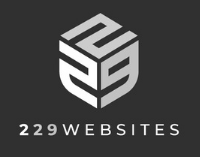How to Create an Effective Website Design for your Small Business
Creating an Effective Website Design for your business: Tips and Techniques for Success

In the digital sphere of 2023, web design is more crucial than ever to the success of any business. A thoughtfully designed law firm website, gym website, restaurant website, or other types of small business website serves not only as your virtual storefront but also as a vital communication tool ensuring your audience knows exactly who you are and what you're offering. Yet with technology and user preferences constantly evolving, creating an effective web design can feel like hitting a moving target.
This post aims to demystify this process by presenting proven tips and ground-breaking techniques geared toward ensuring your website's resonance in this competitive era. Buckle up as we guide you on our stride toward web design sophistication!
An effective website design should consider the target audience and purpose of the site, incorporate brand elements like colors and fonts, have clear and easy navigation, be optimized for mobile responsiveness and search engines, and provide high-value content. Other important elements to consider include proper use of whitespace, consistent design throughout the site, and easy-to-read typography.
By implementing these key elements, you can create a successful website that engages your users and achieves your goals.
Determining Your Website's Purpose and Audience
Determining the purpose and audience of your website is a crucial first step in creating an effective design. Ask yourself: What do you want to achieve with your website? Are you aiming to sell products, provide information, showcase your portfolio, or engage users with a blog? Are you making a law firm website? Are you presenting a restaurant website? Are you planning to make a gym website? Defining the primary goal will guide all design decisions moving forward.
It's also essential to consider your target audience. Who are the people you want to attract to your website? Understanding their needs, preferences, and expectations will help you create a design that resonates with them. For example, if you're targeting young professionals who appreciate modern aesthetics, your design should be sleek and visually appealing.
Once you have a clear understanding of your website's purpose and target audience, the next step is to identify the information architecture that will guide the organization and structure of your site.
Identify the Information Architecture
Information architecture refers to the way information is organized, structured, and presented on a website. It involves determining how different pages and content elements relate to one another and creating a logical hierarchy that allows users to navigate through the site effortlessly.
When identifying the information architecture, start by outlining the main categories or sections that will make up your website. For example, if you're designing an e-commerce site for clothing, your main categories might include "Men's Clothing," "Women's Clothing," "Accessories," and "Sale."
Imagine you are browsing through an online clothing store. You expect to find categories like Men's Clothing or Women's Clothing prominently displayed so that you can easily navigate to your desired section. The same principle applies when designing your own website.
Within each category, further subdivide the content into smaller sections or product types. This hierarchical structure ensures that visitors can quickly locate what they're looking for without feeling overwhelmed or lost. It's crucial to strike a balance between depth and breadth, providing enough detail while still maintaining clarity and simplicity.
Now that you have identified the main categories and subcategories for your website's information architecture, it's time to consider the user experience goals that will guide the design process.
Set User Experience Goals
When it comes to creating an effective website design, one of the first steps is to set clear user experience (UX) goals. UX refers to the overall experience that users have when interacting with a website, including factors such as ease of navigation, responsiveness, and engagement. By setting specific goals for how you want users to feel and what actions you want them to take on your site, you can design a website that meets the needs and expectations of your target audience.
Start by considering the purpose of your website and identifying the primary actions or conversions you want users to complete. For example, if your website is an e-commerce site, your goal may be for users to make a purchase. If it's a blog or news site, your goal may be for users to read articles or subscribe to a newsletter.
Once you have identified your goals, put yourself in the shoes of your users. Consider their needs, preferences, and potential challenges they may face when navigating your site. This empathy-driven approach will help you design a user-friendly interface that addresses those pain points and guides users towards their intended actions.
For instance, imagine you are designing a travel booking website. One of your user experience goals could be for visitors to easily search and book flights or hotels. To achieve this goal, you might focus on creating a simple and intuitive search feature with filters for destination, dates, and price range. You could also incorporate clear calls-to-action throughout the site, guiding users towards the booking process.
Here is an example of setting user experience goals for different types of websites:
| Website Type | User Experience Goal |
|---|---|
| E-commerce | Simplify product discovery and streamline the checkout process |
| Blog | Enhance content readability and encourage article sharing |
| Portfolio | Showcase projects effectively and captivate potential clients |
| News | Provide easy access to latest news updates across different topics |
By setting user experience goals tailored to your specific website type and target audience, you can lay a solid foundation for designing an effective website that meets their needs.
- A Stanford University study reveals that 75% of users judge a company’s credibility based on its website design.
- An analysis by Adobe mentioned that if content on a website is unattractive in its layout or imagery, 38% of people will stop engaging with it.
- Google's research states that websites with a simple design are consistently rated as more visually appealing and trustworthy than their complex counterparts.
Designing with Visual Appeal
Visual appeal plays a pivotal role in capturing and retaining the attention of website visitors. A visually pleasing design not only enhances the overall user experience but also reflects the professionalism and credibility of your brand. To create a visually appealing website, consider the following aspects:
- Color scheme: Choose a color palette that aligns with your brand identity and evokes the desired emotions. Consider using complementary colors and balancing them appropriately throughout your site.
- Typography: Select clean, readable fonts for headings, subheadings, and body text. Pay attention to font size, spacing, and contrast to ensure optimal legibility.
- Imagery: Incorporate high-quality images or graphics that are relevant to your content and resonate with your target audience. Use professional photography or illustrations to enhance the visual impact of your site.
- Whitespace: Don't underestimate the power of whitespace or negative space. It helps create a sense of balance, improves readability, and allows key elements to stand out.
- Consistency: Maintain consistency in design elements such as buttons, navigation menus, and fonts throughout your website. This helps establish a cohesive visual identity and reinforces brand recognition.
- Responsive design: Ensure your website design is responsive and adapts seamlessly across different devices and screen sizes. This guarantees a consistent user experience regardless of how visitors access your site.
While eye-catching visuals are essential, it's important not to sacrifice functionality for aesthetics. Striking the right balance between visual appeal and usability is key for an effective website design.
Remember, designing with visual appeal involves careful consideration of various elements that contribute to the overall look and feel of your website. By following these guidelines, you can create a visually appealing design that engages and delights your visitors.
Choosing and Gathering Relevant Content
When it comes to creating an effective website design, one of the first steps is choosing and gathering relevant content. The content you provide on your website should align with its purpose and cater to your target audience. To make this process smoother, consider these key aspects:
1. Define Your Website's Purpose: Before you start gathering content, clearly define the purpose of your website. Are you creating an e-commerce site to sell products? A blog to share information and engage with readers? Or perhaps a portfolio to showcase your work? Understanding the purpose will help guide your content choices.
2. Consider Your Target Audience: Think about who your website is intended for. Are you targeting young adults, professionals, or a specific niche audience? Tailor your content to their needs and preferences. Conduct research on their demographics, interests, and pain points to create content that resonates with them.
3. Gather Brand Elements: To bring your website together cohesively, gather brand elements such as colors, fonts, and images. These elements play a crucial role in maintaining consistency throughout your site's design. Choose colors that match your brand personality and create visual harmony. Select fonts that are readable and reflect the tone of your content. Utilize high-quality images that are relevant to your brand and message.
4. Map Out Your Website's Pages: Before diving into content creation, map out the pages of your website and plan how they will link to each other. This will help provide a clear structure and navigation for both you and your visitors. Identify the essential pages like the home page, product/service page, about page, blog page, contact page, etc., based on the purpose of your website.
5. Tailor Content for Each Page: Once you have a clear understanding of each page's purpose, begin crafting relevant content for them individually. The home page should grab visitors' attention, providing an overview of what your website offers. Product or service pages should have engaging descriptions and compelling visuals. Your about page should tell a story and establish credibility. The blog page should provide valuable information, and the contact page should offer convenient ways to get in touch.
Remember that content is not just limited to text - it includes images, videos, infographics, and any other media that enhances the user experience on your website.
By taking the time to choose and gather relevant content, you will ensure that your website provides value to visitors, keeps them engaged, and meets their needs. A well-crafted content strategy sets a strong foundation for an effective website design.
When creating a website, it's important to choose and gather relevant content that aligns with the purpose of the site and caters to the target audience. To make this process smoother, define the website's purpose, consider the target audience, gather brand elements, map out the website's pages, and tailor content for each page. Remember that content includes text, images, videos, infographics, and other media that enhances the user experience. A well-crafted content strategy lays a strong foundation for an effective website design.
Creating Effective Navigation
Navigation plays a crucial role in helping visitors navigate through your website seamlessly. It's like a roadmap that directs users to their desired destinations. When creating effective navigation for your website, consider the following techniques:
1. Keep it Simple and Intuitive: Avoid overwhelming visitors with complex navigation systems. Keep it simple and intuitive by using clear labels for menu items. Use familiar icons or text that clearly indicate where each link leads. Organize your menu in a structured manner that makes logical sense.
2. Prioritize Important Pages: Highlighting important pages in the navigation can help guide visitors to key areas of interest on your website. Consider which pages are most valuable or frequently visited and ensure they are easily accessible from the main menu.
3. Utilize Drop-Down Menus: If you have multiple subcategories or sections within your website, consider using drop-down menus to organize them efficiently. This helps prevent overcrowding the main menu while still providing easy access to relevant sections of your site.
4. Implement Search Functionality: Including a search bar on your website allows users to quickly find specific content they're looking for. Ensure that the search bar is prominently placed and easily visible so that users can easily locate it.
5. Optimize for Mobile Responsiveness: With the majority of internet users accessing websites from mobile devices, it's crucial to optimize your navigation for mobile responsiveness. Ensure that menus collapse or transform into a mobile-friendly format on smaller screens, making it easy for users to navigate with their fingertips.
Remember, effective navigation reduces user frustration and encourages them to explore more areas of your website. By creating a seamless and user-friendly experience, you increase the chances of visitors staying longer and engaging with your content.
Implementation and Optimization Techniques for Success
Implementing an effective website design goes beyond just creating an attractive layout. It requires careful consideration of various elements and optimization techniques to ensure success. Let's dive into some key techniques that can elevate your website design and optimize its performance.
1. Prioritize Page Load Time:
In the fast-paced digital world, users expect websites to load quickly. Slow page load times not only frustrate visitors but also impact your website rankings on search engines. To optimize page load time, start by checking if any pages on your website are loading too slowly using tools like Google Search Console. This will help identify areas that need optimization.
2. Optimize Core Web Vitals Metrics:
Google introduced Core Web Vitals metrics as ranking factors for user experience. These metrics include Largest Contentful Paint (LCP), First Input Delay (FID), and Cumulative Layout Shift (CLS). By prioritizing these metrics, you can enhance user experience and improve your website's performance in search engine results.
Imagine a potential customer visiting your website but leaving because of slow-loading pages or frustrating user interactions. By optimizing Core Web Vitals metrics, you increase the chances of retaining visitors and converting them into customers.
3. Utilize Priority Hints and Native Image Lazy Loading:
Browser features like Priority Hints, introduced in 2022, can optimize the Largest Contentful Paint metric by indicating the importance of images or resources on the page. Additionally, native image lazy loading with the loading='lazy' attribute allows images to load only when they are visible on the screen, reducing unnecessary loading times without requiring a JavaScript library.
4. Address Render-Blocking Resources:
Render-blocking resources, such as HTML, CSS, and some JavaScript files, can significantly impact page load time. To improve performance, analyze these resources and remove or defer any that are not essential for the initial rendering of the page. This optimization technique ensures that users can start interacting with your website faster.
5. Optimize for Interaction to Next Paint:
The Interaction to Next Paint (INP) metric measures how quickly your site responds to user input, such as clicking a button or selecting an option. It considers not only visual changes but also functional responsiveness. By optimizing for INP, you create a seamless and responsive user experience, enhancing engagement and satisfaction.
Think of INP as the difference between a website where you click a button and nothing happens for several seconds versus one where the action is instantaneous. The latter keeps users engaged and encourages them to explore further.
Remember that optimizing your website is an ongoing process. Continuously monitor its performance using tools like DebugBear or other similar tools for ongoing optimization and problem detection.
By implementing these optimization techniques, you can create an effective website design that not only captures users' attention but also provides a seamless user experience. Prioritizing page load time, optimizing Core Web Vitals metrics, utilizing browser features like Priority Hints and native image lazy loading, addressing render-blocking resources, and optimizing for Interaction to Next Paint are crucial steps towards achieving success in website design. Keep refining and improving your website over time to ensure it remains relevant and engaging to your target audience.

SEO Services
West Virginia
- Morgantown WV
- Huntington WV
- Martinsburg WV
- Parkersburg WV
- Wheeling WV
- Beckley WV
- Fairmont WV
- Clarksburg WV
- Princeton WV
Virginia
- Richmond VA
- Virginia Beach VA
- Alexandria VA
- Arlington VA
- Chesapeake VA
- Norfolk VA
- Fairfax VA
- Roanoke VA
- Fredericksburg VA
- Charlottesville VA
Ohio
- Columbus OH
- Cleveland OH
- Cincinnati OH
- Dayton OH
- Toledo OH
- Akron OH
- Canton OH
- Youngstown OH
- Dublin OH
- Westerville OH
Kentucky
- Louisville KY
- Lexington KY
- Bowling Green KY
- Paducah KY
- Owensboro KY
- Florence KY
- Elizabethtown KY
- Richmond KY
- Frankfort KY
- Ashland KY
North Carolina
- Charlotte, NC
- Raleigh, NC
- Durham, NC
New Jersey
- Morristown, NJ
- Jersey City, NJ
- Hoboken, NJ
- Long Beach Island, NJ
- Cherry Hill, NJ
Florida
- Orlando, Florida
- Tampa, Florida
- Jacksonville, Florida
Website Design Services
West Virginia
Virginia
Ohio
MAIN OFFICE
Have a question?
Email us
We will get back to you as soon as possible
Please try again later








